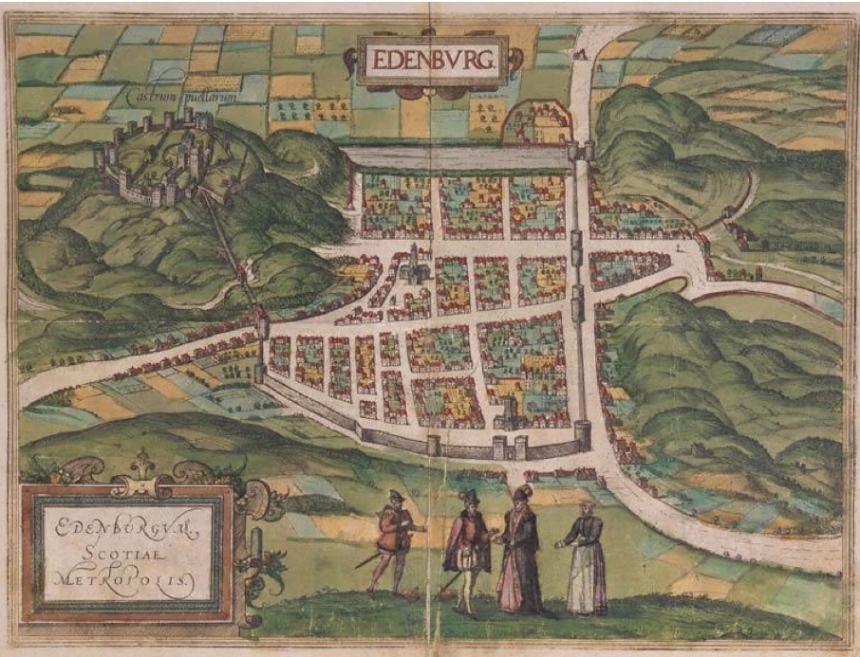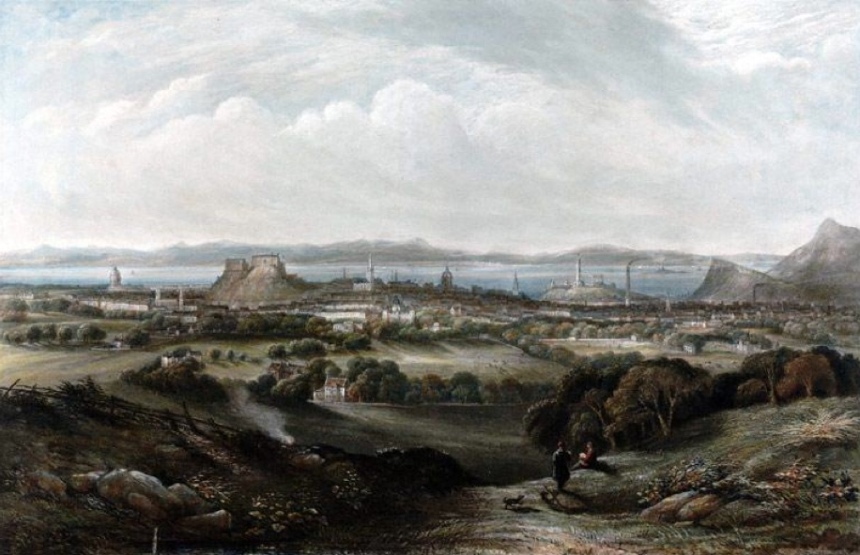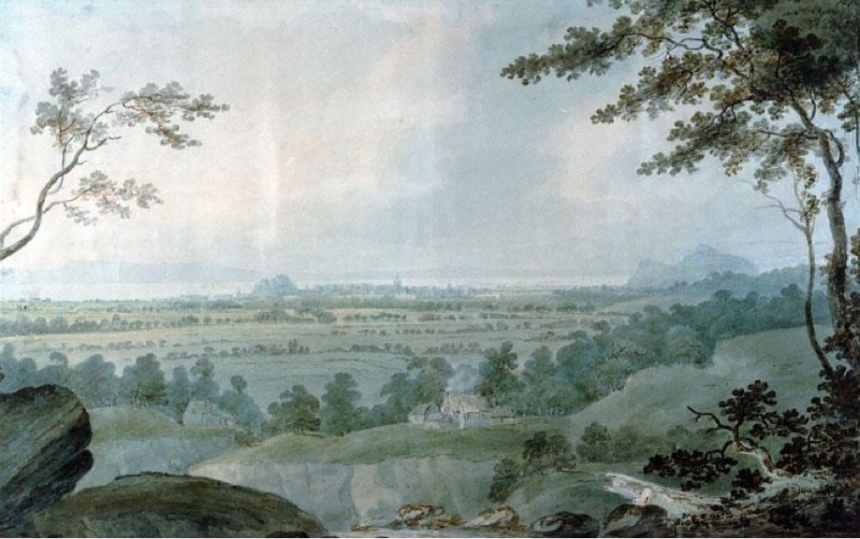As with many other woolly folk in Scotland, my thoughts and horizons are at the moment fixed on Edinburgh – where I will be in a couple of weeks time to attend Edinburgh Yarn Fest. I lived in Edinburgh for a decade, and it remains my all-time favourite city — not least because of its spectacular landscape, in which I loved to walk. I was put in mind of one of my favourite Edinburgh walks today, as we’ve been out photographing a new version of my Braid Hills cardigan — a design which celebrates one of Edinburgh’s most spectacular vantage points, and which I’ve reworked for a new kit. I wrote a wee essay about the Braids a couple of years ago, and I thought I’d share it with you today. (If you are visiting Edinburgh for the Fest, and fancy taking some time out from the hectic marketplace and classes, I highly recommend a walk on the Braids! And if you are among the lucky few who are taking my friend Felix’s colourwork class “Colours of Edinburgh” in a couple of weeks time, you will learn more about Edinburgh’s hills and their geology.)
——————————————————————
The Braid Hills have for centuries been one of Edinburgh’s principal vantage points. Cartographers and geologists, poets and artists, have all ascended “The Braids” to enjoy the spectacular views they afford of this singularly spectacular city.
Situated a couple of miles South of the Old Town, “The Braids” are an undulating shoulder of land, shaped by ancient glacial activity and rising to just under 700 feet. The name “Braid” does not, as might be imagined, come from the Lowland Scots word for ‘broad’ but is rather derivative of the Gaelic term for “upper part” – braghaid – which is familiarly rendered in Scots as “brae” or “braid.” Close to Scotland’s capital, yet with a distinctly rural character, “The Braids” have served the city as hunting grounds, pasture, and a strategic lookout-point for Oliver Cromwell’s army.
For Edinburgh’s Romantic-era poets, the “furzy hills of Braid” were a favourite rural retreat. Here, Robert Burns loved to wander, and Robert Fergusson celebrated the hills in a pastoral poem which counseled his readers to forget “the city’s allurements” and “to this spot of enchantment retire.”
By the mid 1830s, Sir Walter Scott, who had played there as a boy, expressed concern that the picturesque prospect of the Braids would be destroyed if the “skill and capital of the farmers of Midlothian” turned the land over to the production of grain and turnips to supply a hungry and rapidly expanding city.
Thirty years ago” lamented Scott, “the Hills of Braid were in the state of a wild sheep pasture, partly consisting of the softest and most verdant turf, covered with whins [gorse] and broom, through which the grey face of the rock showed itself at intervals. Through this scene strayed the little rivulet in its narrow glen, into which, when his eye was satiated with the magnificent view from the hill, the stranger might descend, as into a silent and solitary scene which might have been many miles distant from the abode of man. . . An old man,” he concluded “may feel some regret at the change of scene and the destruction of the sylvan retreats of his childhood.”
Whether or not one could ever properly describe a sheep pasture as “wild”, Scott’s fears for the effects of the dreaded turnip on Edinburgh’s suburban landscape were to prove unfounded. By the end of the Nineteenth Century, much of the land surrounding the hills of Braid and Blackford had successfully been purchased by the City of Edinburgh, while the estate of the Hermitage of Braid was gifted to the city by its final private owner in 1938. The terms of the gift were that the land be used “as a public park or recreation ground for the benefit of the citizens.” While much of the lower Braid Hills now seem to exclusively benefit a single class of citizen (golfers), the surrounding landscape has statutory protection and looks very much as Scott described it 200 years earlier.
Because of their location South of the city, The Braids are perhaps less visited by tourists than some of Edinburgh’s other hills. In Winter, they are the exuberant domain of snowballers and sledgers; in Spring, they are the ideal spot for a breezy family walk among the gorse. At all seasons of the year, the view of the spectacular city remains spectacular. I have spent many happy days wandering about The Braids and is one of my favourite Edinburgh places precisely because it is a public space, frequented by the fine folk that live here. The Braid Hills are a place where all can enjoy and celebrate the beauty of Edinburgh – surely one of the world’s most spectacular cities.
Images, top to bottom: 1940 map of Edinburgh; City Plan of Edinburgh from the Braids, 1546. Sketch of Edinburgh by JW Turner, 1831; (anon) 1837 view of Edinburgh; 1851 view of Edinburgh by Duguid; Watercolour of Edinburgh from The Braids by unknown artist, 1870; National Geological Survey diorama of Edinburgh from the Braids; Sledging on the Braids in the ’60s; early nineteenth century print “view of the old city of Edinburgh”









Hi Kate, really love this piece. I have roots in Edinburgh though I haven’t been for years. Really interesting take on the hilly landscape and how its impacted patterns and textiles.
LikeLike
See you there soon! Thank you for the recommendation and background.
LikeLike
I am just plain jealous that you get to be in Edinburgh!
LikeLike
Such an interesting essay and I love the pictures. I have never been to Edinburgh and probably will never get the opportunity to, but I have read so much about it and would just love to visit. I love that cardigan as well.
LikeLike
I enjoy reading EVERYTHING that you write…
LikeLike
I am working the Braids cardigan now. At the sleeves. Maybe Ill make another.
LikeLike
AH! Love this pattern…I am relatively new to your posts in the last year and now have (finally) made my first pattern purchase :~) (!!!)
I was entranced by the history and images. Like many, I am an avid fan of Edinburgh’s beauty. I am reading all my Scotland books right now as I am traveling over in May. One of the books, Old and New Edinburgh, I cherish. It belonged to my great, great uncle. The copyright is 1882 and has wonderful history and lithograph (?) images from 1600’s, 1700’s and of coarse 1800’s. Very odd to read about Queen Victoria in the present tense!
Thank you again for your lovely knitwear designs, beautiful photographs, and inspirational posts.
LikeLike
You may wish to make a stop at The Lodge Coffeehouse at 69B Braid Road by Hermitage Gardens! It’s in a beautiful converted gatehouse. The coffee & food are fantastic! Found it serendipitously a few weeks ago.
LikeLike
Just bought the original pattern from Ravelry but holding on for the revised version in case I want to do that instead!
LikeLike
Was totally unaware of these hills, so thank you so much for enlightening me of a place that definitely sounds worth a visit. I’m planning a trip to Edinburgh soon so will hopefully have time to see them for myself.
LikeLike
This is so interesting, Kate. Your writing is a delight to read!
LikeLike
Please,Please Kate consider offering your wonderful patterns as separate patterns, as well as in the KITS, I respect the desire to sell your wonderful wool, yet I would like to make these patterns in the future, Miss Rachel’s Yoke is so grand.
LikeLike
worry not – the separate patterns will also be available on Ravelry
LikeLike
Beautiful, beautiful Edinburgh. I have burned to return for years. Your article stoked the fires for my return visit this August. I can hardly wait! So wish I could be at the wool festival.
LikeLike
I totally agree, Edinburgh is my favourite city too!
LikeLike
I am looking forward to the revised pattern. A sweater with a story of beauty and history is my kind of my pattern. Will the recommend yarn be in Buachaille? Hope so. I love your Scottish yarn.
LikeLike
yes! Happy to say that the pattern works really well in Buachaille.
LikeLike
Wonderful place to visit and be! Enjoyed your post today
LikeLike